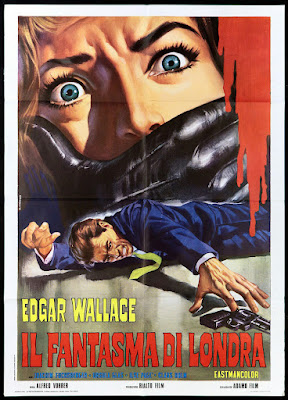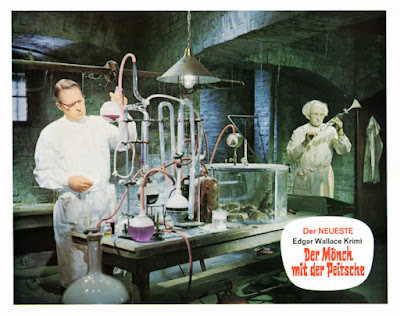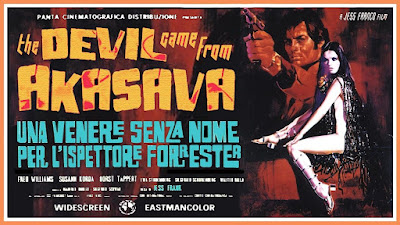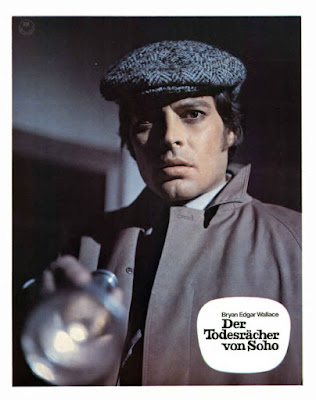A series of murders, performed with the help of a newly developed poison and with the assistance of a convicted prisoner who regularly gets smuggled out of his prison cell, terrorises the girls in a boarding school. On top of that we also have a mysterious hooded monk with a whip who also goes on a killing spree on the grounds of that school. None of the murders seem to have an obvious motive but are orchestrated by a criminal mastermind based in the shadows of his secret underground lair.
Following the success of their Der unheimliche Mönch/The Sinister Monk (1965) just two years prior, Rialto decided to film yet another modern day movie featuring a strange monk only this time in full glorious colour. And rather than have Harald Reinl on the directing chair, Alfred Vohrer takes up the reins.
Rather than simply make this a remake as they had e.g. done with their Dead Eyes of London/Gorilla Gang combo, this production is not really based on Edgar Wallace’s The Terror like the previous film but only carries over a few elements but is otherwise a totally new story by Herbert Reinecker (aka Alex Berg).
In actual fact at one point in the film Sir John (Siegfried Schürenberg) and Inspector Higgins (Joachim Fuchsberger) reminisce about the similarities of these new events with the older case, thereby establishing a link within the Rialto Universe of Edgar Wallace films even though only Sir John had been a participant in the hunt for the Sinister Monk. Instead Harald Leipnitz as Inspector Bratt was in charge of the investigation then.
And speaking of that universe: Fuchsberger returns back to the Rialto Wallace Krimi fold after a three-year break and this is now the second time after Der Hexer/The Ringer (1964), his previous Wallace, that Joachim Fuchsberger plays Inspector Higgins though all references to his character in the earlier film are eradicated, most notably his fiancée (played by Sophie Hardy) and Higgins himself appears to be way less flirtatious than in the earlier production. In the interim he instead seems to have developed that somewhat irritating habit of constantly chewing on something. Chewing gum perhaps that is meant to show him as a “cool” representative of a younger generation?
In the following year’s Im Banne des Unheimlichen/The Zombie Walks (1968) Fuchsberger would for the third and last time play an Inspector Higgins though it’s safe to say that all his Inspectors regardless of the name are generally variations on a theme.
In terms of the relationship between Sir John and Higgins, it is the usual comical interplay between the older buffoon and the younger hero. Sir John in this movie has taken up a recent interest in psychology much to the dismay of his subordinate who tries to prevent him from getting too enraptured in Freudian analysis. Truth be told though, it is actually often Sir John who discovers important clues when questioning suspects in a way that had been dismissed by his younger colleague. It kinda makes me long for some fanfiction in which Sir John is portrayed as the true misunderstood hero of the series.
Ilse Pagé returns for the second time as Sir John’s secretary Mabel Finley, a part she would regularly play for both Schürenberg’s character as well his successor Sir Arthur (Hubert von Meyerinck).
Like many a Euro Cult film, this is a movie that was produced for maximum effect and not for anything requiring internal logic.
There are many aspects of the plot that just don’t make a hell of a lot of sense.
Why e.g. go to the trouble of creating a brand-new poison that can’t be detected by smell or taste when it then requires overly complicated contraptions that leave a clearly visible liquid mess behind on the faces of the victims, the kind of fluids than in certain scenes of the movie actually look more like thin threads of spiderwebs?
Just who actually produces all the poison after the mad scientist who developed it hands over the one and only sample at the beginning of the film just to subsequently be quickly offed as the first victim of the monk?
And why is poison needed at all if we also have a murdering monk on the rampage?
A prestigious boarding school seemingly consists entirely of teachers that all have a dubiously suspicious past with no apparent vetting ever being done. Where else can you find ex-convicts and murderers or former circus artists in such distinguished pillar-of-society roles?
When the true motive behind the killings is revealed - no spoilers here - it does appear to be ridiculously elaborated for the intended outcome.
And this is just the cream of the crop of head scratchers this film has to offer.
So if you need to make proper “sense” of a film, then The College Girl Murders is likely not for you.
But then you would also miss out on a glorious piece of cinematic madness.
In true Grand Guignol fashion the film begins with an image of lab rats hovering one on top of each other before being gassed by a typical wild-haired mad scientist (Wilhelm Vorwerg).
In the first five minutes of the film we already have two murders and the film never lets off pace.
The eponymous hooded monk, dressed in a crimson habit and armed with his whip is clearly one of the if not THE most iconic villain in the Wallace universe. His black and white predecessor was already an imposing idea but seeing him stalk the school-ground at night in flashy red colour makes for a truly outrageous image.
The main villain’s underground lair protected by crocodiles and set seemingly underwater though in reality within an enormous aquarium looks stunning and is clearly reminiscent of the James Bond movies, especially of the later The Spy Who Loved Me. The villain himself lurks Dr Mabuse-like with the back towards his henchmen and speaks in an electronically changed voice through a loudspeaker and at opportune moments switches off the lights in his reception area to be even more obscured.
Including reptiles in his movies was one of Vohrer’s identifiable traits and a love for the grotesque permeates this film, especially when one of the henchmen holds a squirming rat in his hand in order to feed it to a snake. (I am not entirely certain that no animals were harmed during the production of this movie.)
Especially the night scenes are beautifully and moodily lit for greatest effect courtesy of cinematographer Karl Löb who next to directors Reinl and Vohrer needs to be highlighted as one of the most important artists to define the typical Krimi look.
The first girl that gets killed in a church after being handed a specially prepared bible containing a gadget blasting out the poison is a heavily bespectacled Ewa Strömberg in her first small role in a Wallace Krimi. Strömberg in the early 1970s would become one of Jess Franco’s muses in a handful of his films shot in very short succession before retiring from the film industry completely at a fairly young age.
Everything is over the top and everyone sweats like a pig when under pressure. Pretty much every character has some dirt on them and is therefore suspicious and the dynamics are quite often highly outrageous, especially in the case of a pervy older teacher (Konrad Georg) with a crush for some of the younger girls (first the murder victim and then the character played by Grit Boettcher). He is also seen to spy on some of them via underwater windows in a swimming pool and through the kind of removable peepholes in the walls of a girls dormitory that were seemingly everywhere in Krimiland. And yet, despite all this extremely creepy carry-on the girls in question do seem to welcome his attention and reciprocate!
And all of this is underlined by Martin Böttcher’s gloriously madcap and over-the-top soundtrack.
Following an unrelated supporting role in The Sinister Monk and a star making performance in the Karl May film Winnetou und das Halbblut Apanatschi/Winnetou and the Crossbreed (1966), The College Girl Murders was only Uschi Glas’ third feature film.
The following year she personified the ésprit of a confident independent young generation in the Nouvelle Vague inspired freewheeling cult classic Zur Sache Schätzchen/Go for It, Baby (1968) and “Schätzchen” would remain her well known nickname while she developed into the Nation’s Sweetheart over the years. Ultimately she would appear in a total of five later-day Rialto Wallaces.
In this film she plays the most prominent girl in the boarding school. Though it appears that together with the others she would clearly be too old to stay in one of those educational institutions, her character is meant to be 20 so it appears not to have been that unusual to have students remain until the age of 21.
Despite becoming most famous through a hip role, for the most part Glas through the course of her career became a representative of an inoffensive kind of conservative entertainment and even in this early role she appears quite precocious and despite her young age already very mumsy. She is maybe not the typical cheesecake one would expect in exploitation flicks around all-girls schools…. but then again surprisingly very few of the other actresses aren’t either.
Glas has her best parts here when interacting with Fuchsberger dressed up as the monk or while hanging captive in a cage over the crocodiles.
One of the most enjoyable, albeit head scratching aspects of The College Girl Murders is the entire prison subplot. Siegfried Rauch plays an inmate who regularly gets smuggled out of and then back into the prison in order to commit murders with the help of a futuristic looking gun containing that poison. Initially reluctant to go that far he gets coerced into it by his cellmate (Narziß Sokatscheff).
It appears that pretty much the entire prison, inmates as well as staff, are in on it.
With one seeming exception, a Reverend (Rudolf Schündler), who when visiting Scotland Yard starts slapping bums as he is indeed an undercover member of the vice squad!
Also look out for other familiar faces such as Harry Riebauer, Tilly Lauenstein, Claus Holm, Jan Hendriks and the always memorable Günter Meisner.
When an “Ende” sign gets dropped into the aquarium to signal the end of the film, we return back to the familiar breaking of the forth wall.
The Rialto colour productions are often “trashier” than its black and white predecessors and quite commonly revisit familiar well established tropes even if they’re not outright remakes and The College Girl Murders is no exception.
Depending on your stance towards this kind of style-over-substance film making, this film may be considered either one of the highlights or the low points of the series.
Me?
I love it and it certainly ticks all the right boxes with its mix of Wallace meets James Bond by way of Dr. Mabuse.








